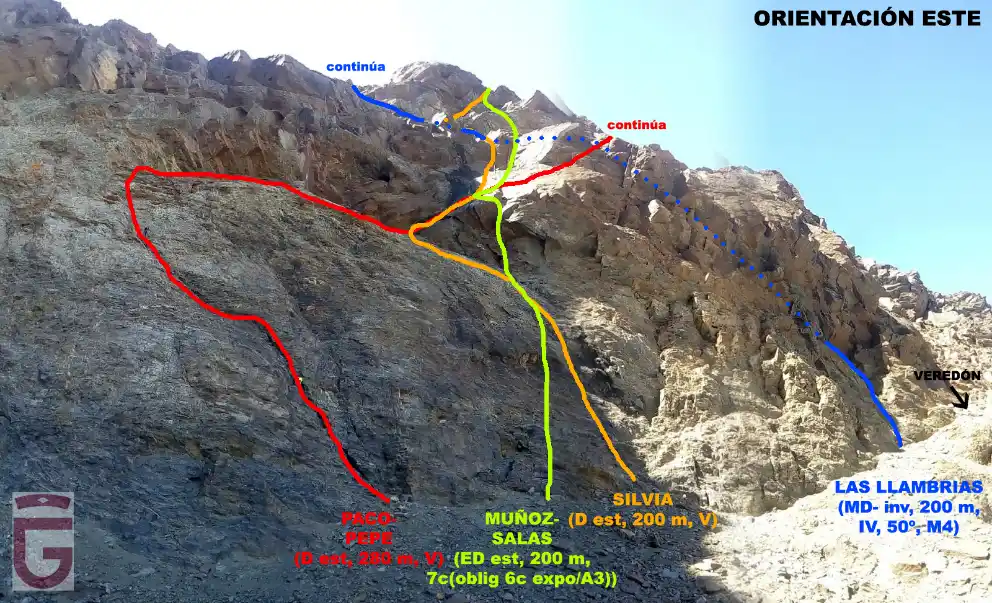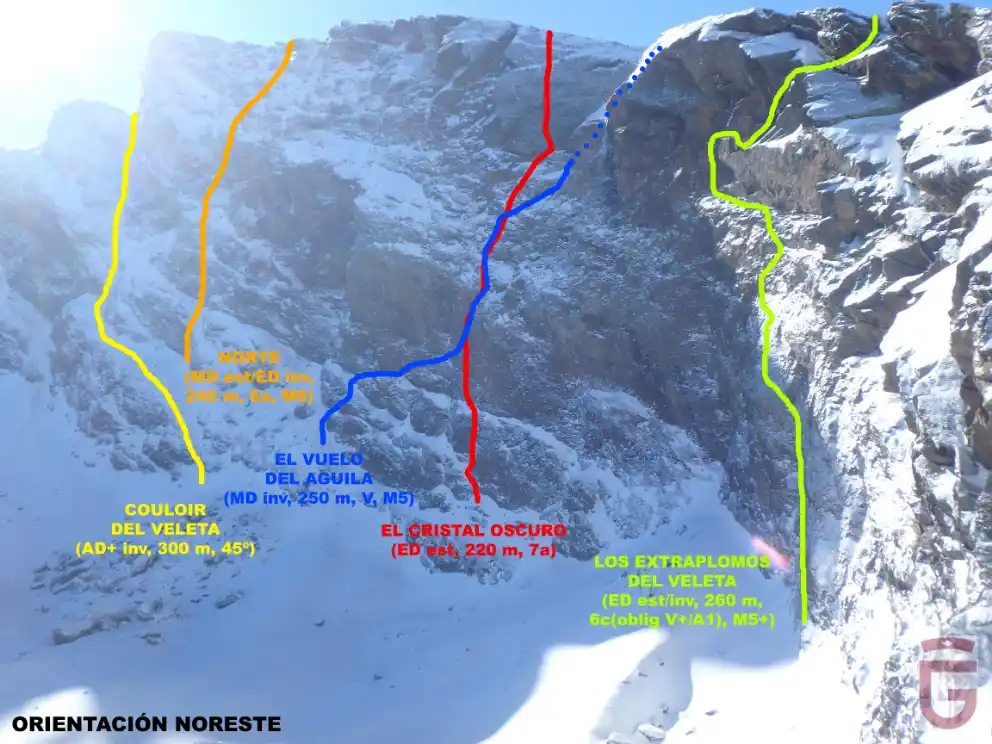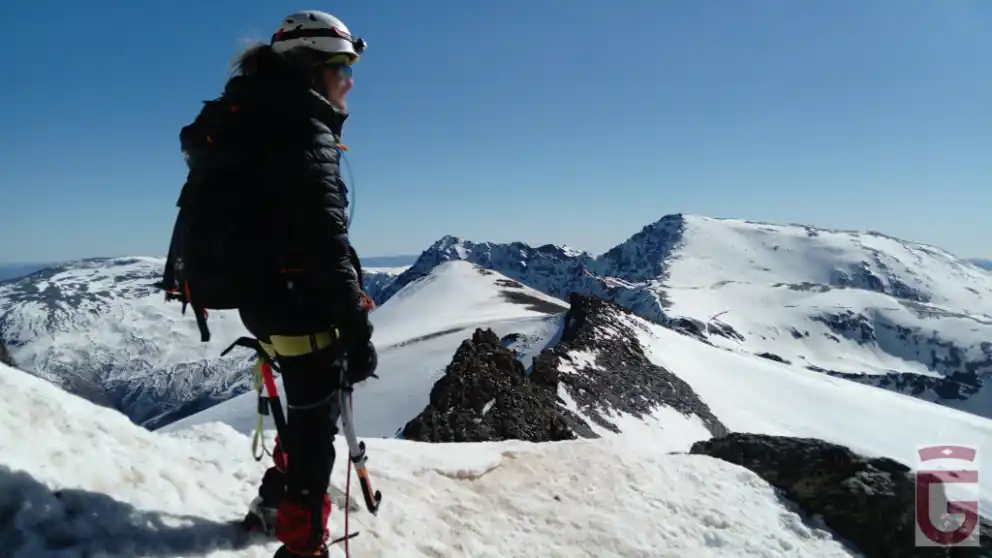For more complete and detailed information on the climbing routes that run along the northern slope of the Veleta, we recommend consulting the "Veleta Special" published by CampoBase magazine in December 2016 (No. 149), a publication from which we have obtained, and with which we have contrasted, much of the information set out below.
APPROXIMATION
The approach to the north of the Vane begins in the Hoya de la Mora (point 0), also known as Los Albergues, due to the existence there of two lodgings of this type: the university and the military, the latter called Capitán Cobo.
From Los Albergues we will depart to the south, in an ascending direction following the alternating section of lane and trail that will permit us to cut through what will be our way through the old Granada-Alpujarra road, which zigzags over Loma del Veleta. The existence of snow may cause the disappearance of both lanes and trails, so the way we should go will be marked by the skiing tracks, along whose left margin we will transit

After about 2 and a quarter hours from our departure, we will arrive at the height of the Posiciones del Veleta, a former rectangular construction, and some ditches, which constitute the remains of an entrenchment occupied by the "national" forces during the Civil War.
Leaving Las Posiciones behind, we will reach the start of the Veredón. (point 1, a trail that travels obliquely through the Tajos del Campanario leaning on a ledge, and which will allow us to descend to Corral del Veleta(punto 3), the basin of glacial origins that, supported by a moraine, is located at the foot of the northern slope of the Picacho
Under winter conditions, the Veredón will appear clear if there's little snow so, if there's no ice, it can be descended without much problem. However, if the snow is abundant, the Veredón will be hidden under a very steep snowy slope, a circumstance that will be aggravated if there's ice instead of snow. In this case it is advisable to avoid the hillside, very exposed, and use the installation for abseiling (point 2) that exists a little above the Varedón, behind an obvious gendarme and that, after 50 or 60 meters of descend (depending on its condition), will drop us above the Corral (be careful! With ice or hard snow it will be essential to secure ourselves to the slope before releasing the ropes).

(winter conditions). The northern slope of the Veleta in the background

(under winter conditions with ice and frosted snow).
CLIMBING IN SUMMER
The descent to the Corral del Veleta (point 3), under summer conditions, that is to say, without snow, will be done by comfortably following the Veredón.
Once descended the Veredón the first thing we will find on our left will be the east wall, continuation of the north wall of the Veleta. On this wall we will point out two climbing routes eminently summery: the Silvia and the Paco-Pepe.
The Silvia (D, 200 m, V), with 5 pitches, is the most repeated summer itinerary of the north of the Veleta, due to its moderate difficulty and the great quality of the rock.
The most difficult step of the Silvia is located at the first pitch: a plated Vº degree step protected with a parabolt. Already in the second pitch, we will find the “step of the lizard” (V), crossing a narrow ledge that, contrary to what might seem to be by its name, is more simple to overcome “from the outside” (with good grips for the hands on the ledge and feet in adhesion).
In the third pitch, we will find a nice dihedral (V) protected with two pins.
Surpassed the third pitch, already high on the wall, the difficulties decrease.
In all the meetings of the Silvia will find one or two bolts.
The Paco-Pepe (D, 280 m, V), with 7 pitches, is, along with the Silvia, another of the popular trails of the Veleta due to its low technical difficulty.
The first two pitches of the Paco-Pepe follow a clear diagonal veer to the left to (IV) hat avoids the difficulties of climbing in plate and in collapse of the beginnings of the Silvia and the Muñoz-Salas respectively.
Once we have passed the left vira, we will make a right traverse, under an overhang, and on a platform, to finish overcoming the "paso del lagarto" (V) and reach the second meeting of the Silvia (third and fourth pitches).
The fifth and sixth pitches of the Paco-Pepe continue diagonally, with a tendency to the right, and cross the "great llambría" of the Veleta to then return to the vertical following a channel. From there the route runs diagonally, now to the left, and through simple terrain (IV), until leaving the wall.
To the left of the Paco-Pepe route, oriented to the northeast, we will find other great summer classics of greater difficulty: Los Extraplomos del Veleta and El Cristal Oscuro among them.

(under summer conditions).
WINTER CLIMBING

(under winter conditions)
The Couloir del Veleta, or, simply, the Couloir, for its aesthetics, its proximity, and its affordable difficulty, is one of the most popular winter routes in Sierra Nevada.
Their technical difficulties (AD+, 300 m, 45º), which should never be underestimated (as it depends a lot on the conditions, which are very changeable), lies mainly in the access traverse to the snow corridor and in the exit to the summit via the Fidel-Fierro route (III+) of the south face.
The diagonal traverse that gives access to the corridor can be done through two traverses or ledges: an upper one, narrower, and a lower one, wider; it is highly recommended to do it through the latter, which is less exposed, although this decision forces us to climb a short final wall before starting the ascent through the corridor.




When we reach the top of the snow corridor (45º) we will have views over the valley of the Veleta River, which rises at the foot of the south face of the Picacho to join the Naute, a tributary of the Poqueira.
A right-hand ledge will allow us to traverse horizontally along the south face of the Veleta until we reach the base of a short wall that constitutes the beginning of the Fidel-Fierro route.
Once we have passed the wall, we will go through an ascending turn, to the right, until we reach the base of a wide chimney, which we will climb going out from it to an upper ledge. Traversing the ledge to the right or to the left, we will face the vertical, overcoming a last climb, and directly reaching the geodesic vertex of the Veleta (point 4).
If there is snow on the south face of the Veleta, this, due to the orientation, is usually of the "spring" type.



In addition to the Couloir, but oriented to the east, we will find another route of moderate difficulty that, with good ice conditions, becomes an interesting winter itinerary. This is Las Llambrias.
The Llambrías of the Veleta (MD-, 200 m, IV, 50th, M4), con 4 largos, discurre a través del sistema de llambrías (placas tumbadas) que, en diagonal (de abajo a arriba, y de derecha a izquierda), recorren el sector este de la pared del Veleta.
The first pitch of Las Llambrías runs through the first inclined planes of this system, separated from each other by a traverse (protected by a parabolt) and by a narrow funnel. Once on the upper plate of this first pitch, we can protect the climb with short ice screws (if the ice layer is stable and sufficient), or by using some of the existing parabolts on the right wall.
The second pitch runs over the "great llambría" of the Veleta, a plate on which rests in winter a large hanging snowfield that is traversed diagonally.
The third pitch, in traverse (first ascending and then descending), crosses the fourth pitch of the Silvia and takes us to the step that, once overcome (with the help of a parabolt), leads to the upper slabs. Once this difficulty has been overcome, the route seeks the vertical through ice and rock projections and moderately steep snow ramps.
A logical alternative to exit The Llambrías, especially if the step that gives access to the upper plates is not in good condition, consists of climbing the last over of the Silvia to leave for her from the wall.
Other routes of marked winter character of the Veleta, although more difficult than those described above, are the North and the Vuelo del Águila.
RETURN
The climb will end at the summit (point 4) or, in any case, on the western slope of the Veleta.
Descending through the western slope of the Veleta we will soon reach the route of the old Granada-Alpujarra road: an unpaved lane in summer and a ski slope in winter (point 5). Following this route in a descending direction, we will soon reach the vicinity of the Posiciones del Veleta, from where we will only have to undo the path we took during the approach to end up returning to the Hoya de la Mora (point 0).



